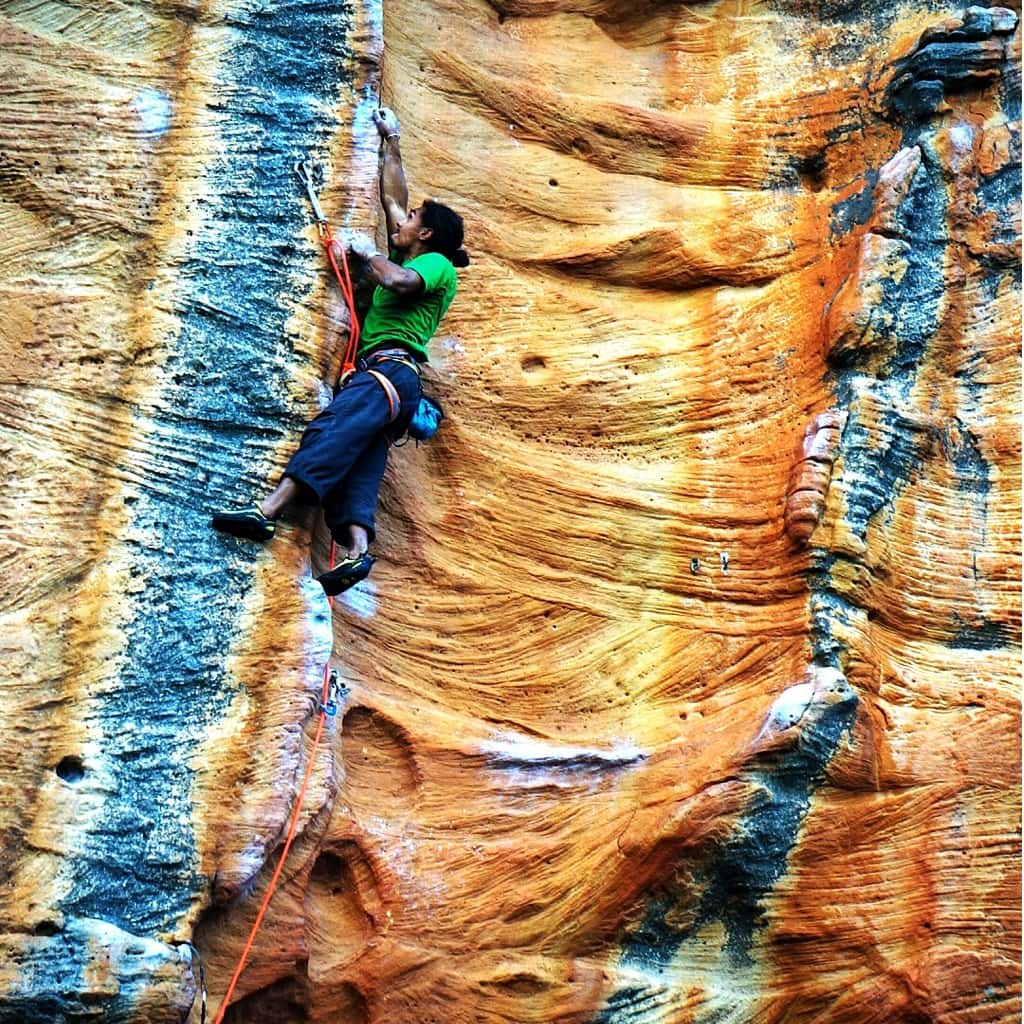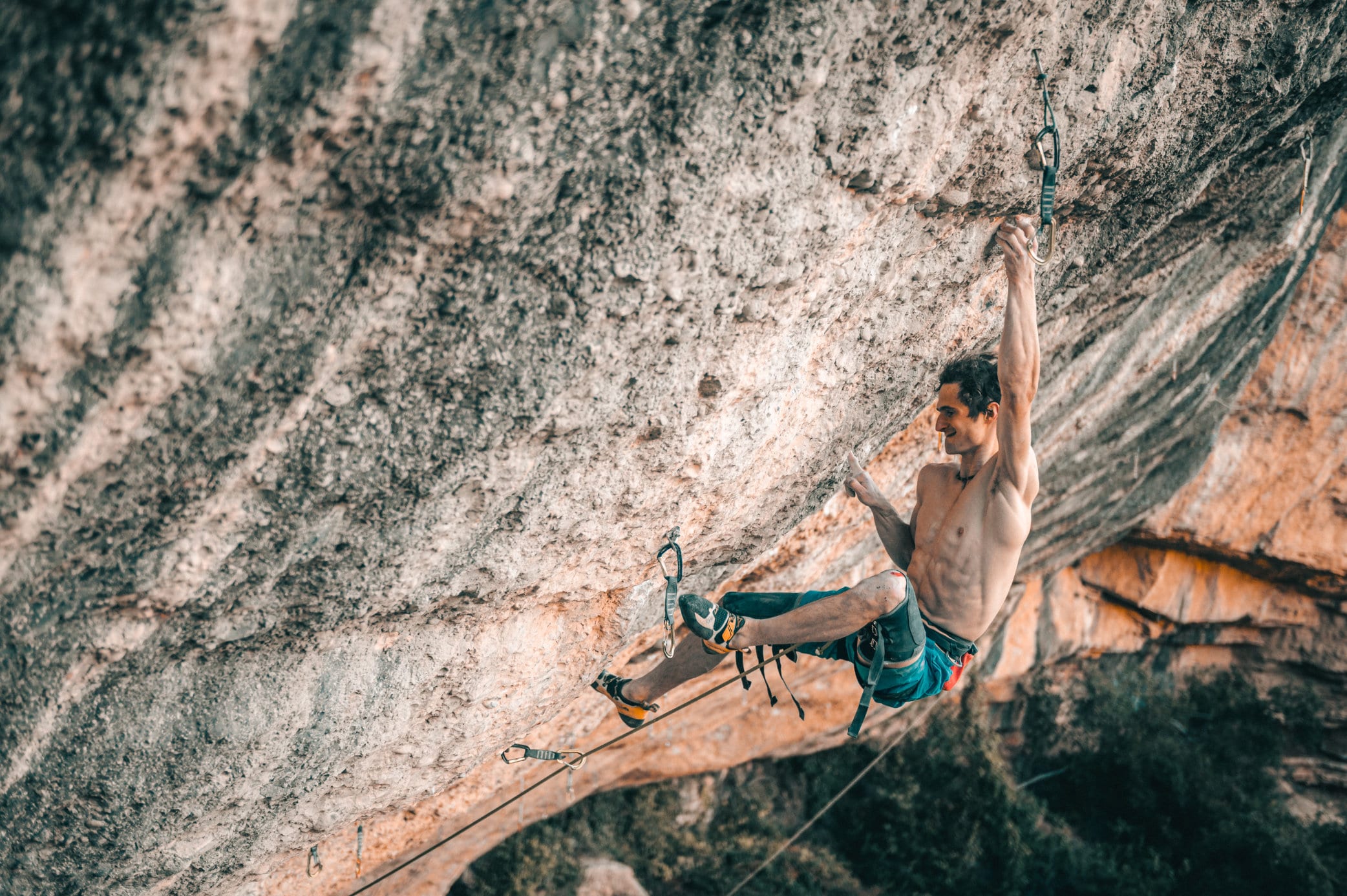An onsight means successfully sending a route on your first try without any information/beta. In most cases, you will onsight only climbs that are easy for you. Onsighting a hard route near your limit is probably the most difficult challenge there is in rock climbing. There’s no shortage of things that can go awry—you can read sequences wrong, not see key holds, hesitate, get nervous and pump out. This article will give you some tips and tricks for how to onsight climbs closer to your limit.
Onsighting is organic. When you do it, it feels like it simply just happened. Really, it’s the culmination of all of the training you’ve done, the routes you’ve redpointed and the things you’ve learned about reading rock climbs and executing moves efficiently. Onsighting is the crucial marriage of your strengths and experiences that come together to help you make an ascent in the best style possible.
There is no shortcut to improving this onsight ability—it comes with both experience and fitness. Check out Adam Ondra’s onsighting masterclass as he walks us through his through process on Just Do It. Though nothing will substitute for years of hard work—just ask Adam Ondra—here are some tips for improving your onsight ability.
Reading the rock
Deciphering an entire sport climb from the ground requires good spatial awareness and memory. It’s similar to foreseeing the moves in a chess game. You have to anticipate every possible move, and decide which one will work best.
Being able to stand on the ground and visualize the climbing sequence—taking note of hand and footholds—is called “reading the route.”
Look for chalk marks. The direction of the chalk often indicates the orientation of the grip. Try to see the left-hand/right-hand sequence.
When the sequence isn’t obvious, look around for clues you’ve missed. Maybe you match and cross through. Are there any features you’re not seeing? Maybe there’s a hidden hold that won’t reveal itself till you’re up on the climb. Make a mental note so that when you reach this section, you’re prepared.
Most important is to try to spot rests from the ground. Are there any obvious-looking jugs? Resting jugs are typically coated in chalk due to climbers shaking out on them and chalking up (in fact, the more chalk there appears to be on a hold, the bigger the hold tends to be). If you know there’s a good rest coming up at the fifth bolt, you’ll try harder to get through that tough sequence at the fourth bolt.
A good onsight climber is both spontaneously creative enough and experienced enough to change up his beta on the spot and go with the flow.

Working the Rests
Spotting rests from the ground breaks the route down into “mini-routes”—the section between each jug/stem.
Think of rests as “checkpoints” you must reach, one at a time. Focus only on moving steadily and efficiently from one resting spot to the next.
If the rest is really great (a sit-down on a ledge, etc), there’s no reason not to stay there until you’re back to 100 percent. While resting, look ahead and gather as much information about the upcoming sequence as you can.
Sometimes, rests aren’t as good as we had hoped. Maybe the hold we thought would be a jug ended up being a sloper—good enough to shake out on, but not good enough to get it all back. Knowing how long to rest in these situations takes a keen awareness of your own body and its ability to recover.
Ethan Pringle says that resting too long in these situations is a common mistake.
“I think a good rule of thumb is don’t rest longer than the time it took you to reach the rest,” he explains. “It took me a long time to realize this. For years, I would shake out forever because I could hang on forever, but then I would get to a long move and I would be spent.”
In other words, if it took you 60 seconds to climb up to the first rest on the route, don’t rest longer than one minute.
Achieve Flow
Efficiency of movement is one in the same with great free-climbing technique. Being efficient on the rock means not wasting energy or adding extra foot or hand movements that could be otherwise skipped.
Efficiency is fluidity. It means getting a rhythm going, and achieving a feeling of flowing up the climb.
An ability to read rock in a split second and move up it effortlessly comes with experience. Broaden your experience by visiting new areas and climbing on as many different types of rock as you can.
Climb efficiently can be practiced in the gym, too. All the holds are marked, and there is usually only one sequence that is set with anthropomorphic movements in mind. Spend a lot of time climbing easy routes in the gym, flowing up the holds to a rhythm. Efficiency does not necessarily mean climbing faster. It means moving to a beat and not stuttering. Achieve flow.

Be Decisive
Ethan Pringle says that being decisive is vital to onsight climbing.
“It’s key to learn how to read sequences from the ground, but even better to learn to improvise while you are on the wall. The better you know how to move over rock, the easier and more natural this will become. You won’t spend as much time hesitating or screwing around with your feet. Knowing when and where to stop, how long to rest, when to punch it, how not to hesitate, and how to just decide to do something and go with it is crucial. Commit to your decision.”
Many onsight attempts fail when a climber’s indecision or hesitation meets a difficult sequence or a pumped-out forearm. The climbers who succeed more often than not are those whose brains work faster. How can you get yourself out of this mess? Come up with a plan in a split second, and commit to it. Be decisive, and execute.
Have Patience
Being decisive, however, doesn’t mean rushing. As important as it is to be spontaneous, it’s equally important to have patience while you climb.
One of the more common errors we commit is climbing as if we are in a rush to reach the top. Climbing can often feel uncomfortable. Whether that feeling is caused because we are scared to be on lead, or uncomfortably pumped, our natural instinct is to rush the movement and get to the top quickly so that our discomfort goes away.
Part of climbing, especially onsighting, is building up a tolerance to that discomfort, and being able to stay calm and centered while focusing on climbing as well as you know how. Don’t rush. Make the next move when it feels right. Make sure your feet are properly set; don’t just paste them to the wall sloppily and try to toss for that next jug.
Identify the problem, and have the patience to solve it. For example, if the problem is that the next handhold seems out of reach, look for a higher foothold. Have you missed any handholds—an undercling, perhaps, that will allow you to make the span? Again, don’t rush the move.
Stay in the present. Focus on making only one move at a time—and make it perfectly. This is advice that not only applies to onsighting, but redpointing as well.
Just Go For It
Alex Honnold says that some of his hardest onsights are the result of just going for it.
“Being able to commit quickly is key,” he says. “Rather than spending time and energy worrying if you’re doing it right, just do it one way or the other. I’ve onsighted several routes where I made blind dynos or throws around bulges because I just assumed there had to be a hold there. I’d get to a point where I was stuck, and figured there was only one place I couldn’t see, and therefore there had to be a hold there. Then, I’d go for it. Of course, I’ve fallen like that too, but that’s life!”




0 Comments